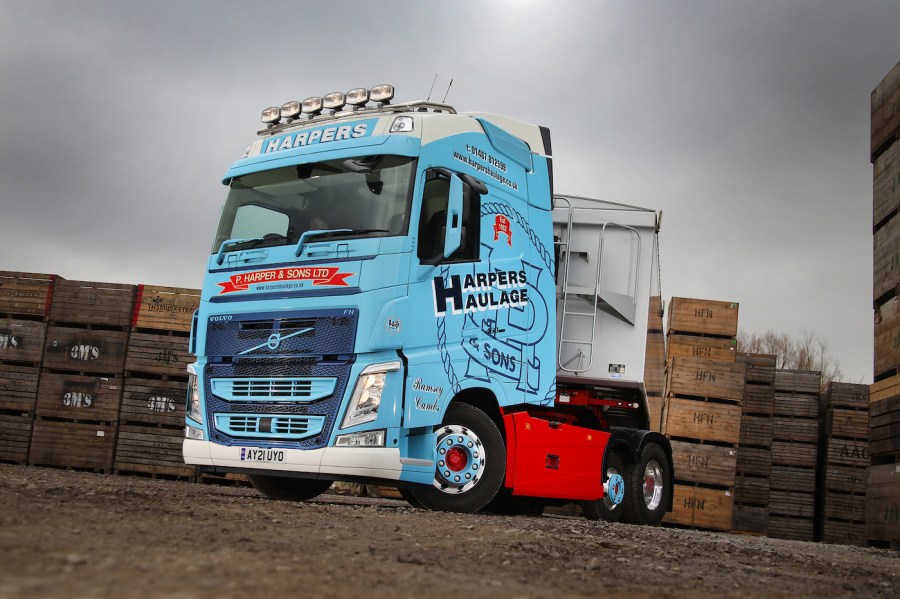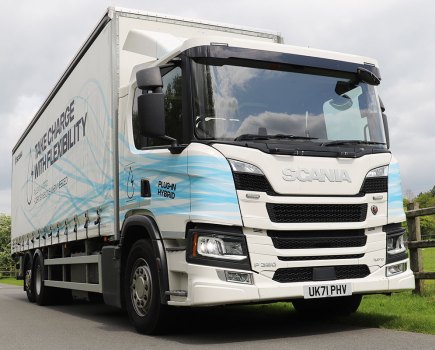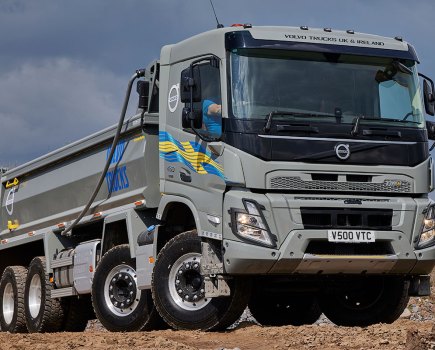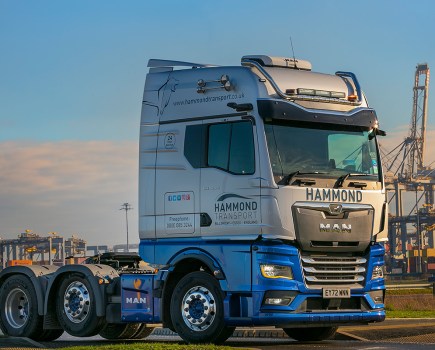We take a year-old Volvo FH460 Turbo Compound for a lengthy run, loaded at 44 tonnes for half of the way.
There are pros and cons with road tests of manufacturers’ demo vehicles. The pros are you usually have a manufacturer rep with you who can answer queries and point you to features. The cons are the trucks are almost always top of the range, or ‘all options ticked’ – which often does not represent most of the vehicles that will actually be bought by operators.
Also, being brand new, there’s no time for any niggles and rattles to appear – and also the test runs are often not as long as you like. Plus, using an operator’s truck on a solid day’s work allows you to do more – we rarely have to reverse trucks on a test drive, for example. We usually don’t couple or uncouple trailer. The load is the same on the whole of a test run, whereas it isn’t on a day’s work.
When we were asked to help out our good friends at Harper’s Haulage in the pre-Christmas rush for spuds, we were more than happy to oblige – providing we could have its eight-month-old FH460 for the day. The truck is one of the last of the Version 4 FHs, but interiors aside the new FH Version 5 isn’t all that different. The driveline is the same, with the latest version of the Euro 6e engine, and there are only a few small detail differences on the outside that set the two models apart. So in that, respect this was a pretty up-to-date truck, certainly from the driving angle.
This example was the 460 bhp version with Volvo’s Turbo Compound (TC) technology. While we’ve driven a few TC models on 90-minute test drives from Volvo’s HQ in Warwick, this was a chance to really put the truck through its paces for a decent drive. Interestingly, we did a second replica run the following week with a Mercedes-Benz 2545, and while this is not a head-to-head appraisal, we can’t help drawing some comparisons. More on that as we go along…
Technical overview
The model we had was an FH460 TC with I-Save technology. Under the cab is the 12.8-litre straight-six delivering 460 bhp and 2600 Nm of torque. It has the small midlift axle favoured by operators who max out on weight – and hauling potatoes will certainly take you to 44 tonnes. This axle option offers another 500 kg of payload, which is not to be sniffed at!
The cab was a high-roof Globetrotter; Harpers’ drivers do multiple nights out and so big cabs are specified on all its trucks. As an aside, the firm has a mixed fleet with examples of Volvo, Scania, DAF and Mercedes all in its attractive sky-blue livery. It had previously also operated Iveco. It is not brand-loyal and has an eye on good deals, and it likes to forge good relationships with dealers and salesmen.
The FH460 has three-step access, so it does not have a totally flat floor like a Scania S-cab, Renault T High or a Merc GigaSpace. But it’s not far off and it isn’t an issue; indeed, for us, a three-step entry and a engine hump of a couple of inches is preferable to four-step access just to have a totally flat floor.
The Globetrotter cab is one of the best around: it’s roomy, has plenty of storage and it’s a lovely working area. In fairness, in this sector there isn’t a bad cab among the seven manufacturers, but few drivers complain about the modern FH cab.
On the road
The run was from Ramsey, near Huntingdon, to Northwich, out loaded and empty back. Some 163 miles were done bang-on 44 tonnes, while the return was a little over 16 tonnes.
The truck uses Turbo Compound technology which boosts torque by about 300 Nm and does so at lower revs, which makes it on a par with a 500 in terms of pulling power (you can have a 500 with TC if required). Harper’s generally specs 450-480 bhp for its tractors, so the FH is well in that ballpark.
The extra torque means the driver has to do less acceleration, which saves fuel – Volvo claims it’s up to seven per cent better on fuel than the non-TC 460 bhp model. Using Volvo’s I-See, which allows the truck to ‘look ahead’ at the topography and select the correct gear accordingly, means the truck will sail up hills in a higher gear and save fuel without losing speed, while maintaining a higher average speed.
One issue we have with many trucks is their cruise control slows them down when approaching a slower vehicle in front. It’s a great safety idea, but we tend to find they slow down too much, too soon, and we find ourselves either having to put our foot down or overtake way too early.
Overtaking by trucks is probably the biggest bugbear of car drivers, so it needs to be done conscientiously and not excessively. If you come up a truck doing 53 mph and you want to go round because you are doing 56 mph, in the Volvo you need to knock off the cruise, get up that bit closer to the point when it’s safe to pull out, and then overtake.
This isn’t just a criticism of the FH; it seems to apply to Mercs, DAFs, Scanias and others. The Volvo’s speed noticeably dropped on the hills, but it was fully loaded. However, it didn’t drop as much as others; in fact, the Merc we drove the following week positively screamed at the sight of a hill and was down into the high 30s as regards miles per hour, while the Volvo was in the low 50s, or high 40s. That’s a major difference for journey times.
Shifting viewpoint
We love Volvo’s I-Shift; it’s a smooth gearchange and in our experience it’s never selected a wrong gear. It’s quiet, effective and easy to use. The gear selector on this model was by the driver’s seat, which we don’t mind for its accessibility, but we prefer dash-mounted buttons/knobs like in an Iveco or DAF, or stalk-mounted systems like Scania and Merc purely because it’s a better use of cab space. Volvo offers dash buttons as an option, and we’d go for that.
However, we’re not so keen on Volvo’s engine brake – it just seems a bit ineffective. It’s not a patch on the superb Iveco engine brake, which is the best in the business; but it is on a par with Scania.
That said, the FH’s electric parking brake is superb; much better than the Merc system we used afterwards. The Globetrotter cab is exceptionally quiet, though the glare on the mirrors can be a bit annoying. Our drive happened just a few days before Christmas so the return was with a low sunset, which caused considerable mirror glare. Perhaps now is the time to go mirrorless, Volvo?
We did like the electric sunblind, though. It took us a while to find where the control button was, but in fairness this is a small gripe born out of personal stupidity!
Verdict
The FH cab is now a decade old and on its second version, but it is still a lovely place to work. It’s better than many on the market, but Volvo can’t rest too easy on its laurels here. This facelift might see it through to its eventual replacement, though it may need one last makeover before the inevitable happens.
Performance wise, this FH was lovely to drive and the run in the rival Mercedes 2545 the following week really rammed home how good the Volvo is, and how it makes light work of hills even when fully loaded. It’s let down by some small niggles, but nothing big enough to have a serious impact on purchasing decision. Many hauliers of a similar size to Harper’s are telling us they are starting to buy the truck a driver wants (within reason of course), and in that respect the FH would be high on any shopping list.
The overall business case for the FH with Turbo Compound is an incredibly strong one. We didn’t measure the fuel consumption on this trip, but Harpers said it has been good so far and it had only just over 102,000 km on the clock – so only just bedded in!
Volvo’s build quality is generally one of the best around. There were no irritating rattles or squeaks, and it gave a relaxing and pleasurable driving experience. In short, it ticks all the boxes. It’s good on fuel, good on weight, good on reliability, good on price and great for the driver.
Any sensible fleet manager, operator or owner-driver should have an FH high on their list for evaluation. Normally the residuals are excellent as well – but in the current market, residuals would be good on a 1996 Hino with two wheels missing and an endangered bird nesting in the chassis. But joking aside, when you do come to sell, you won’t be out of pocket.
We like
- Excellent pulling power
- Superb cab
- Smooth gearshift
- Good fuel economy
- Good build quality
We don’t like
- Sluggish engine brake
- CC can slow down unnecessarily early
Test Specification
- Model: Volvo FH460TC Version 4
- Design GVW/GCW: 44,000 kg
- Chassis: 4000 mm wheelbase
- Front axle: 8000 kg capacity
- Rear axle: 11,500 kg, 4500 kg midlift, 1:2.533 ratio
- Gearbox: I-Shift AT2612F, 12-speed automated manual
- Engine: Volvo D13TC Euro 6d, 12.8-litre, six-cylinder
- Max power: 460 bhp @ 1250-1600 rpm
- Max torque: 2600 Nm @ 900-1300 rpm
- Cab: Globetrotter high roof






